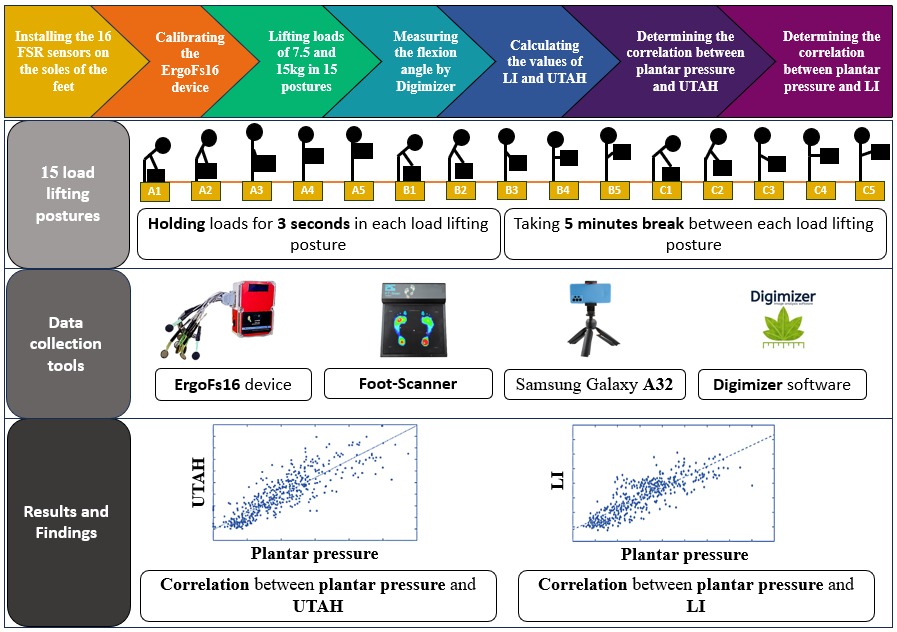Volume 14, Issue 2 (6-2024)
J Health Saf Work 2024, 14(2): 272-290 |
Back to browse issues page
Download citation:
BibTeX | RIS | EndNote | Medlars | ProCite | Reference Manager | RefWorks
Send citation to:



BibTeX | RIS | EndNote | Medlars | ProCite | Reference Manager | RefWorks
Send citation to:
Mehridiz H, Ghasemi M S G, Saeedi H, Varmazyar M, Garosi E. Analyzing the Correlation Between Plantar Pressure Distribution and UTAH Back Compressive Force and NIOSH Lifting Index in Symmetrical Lifting Tasks. J Health Saf Work 2024; 14 (2) :272-290
URL: http://jhsw.tums.ac.ir/article-1-6980-en.html
URL: http://jhsw.tums.ac.ir/article-1-6980-en.html
Hassan Mehridiz * 
 1, Mohamad Sadegh Ghasemi Ghasemi1
1, Mohamad Sadegh Ghasemi Ghasemi1 
 , Hassan Saeedi2
, Hassan Saeedi2 
 , Mahsa Varmazyar1
, Mahsa Varmazyar1 
 , Ehsan Garosi1
, Ehsan Garosi1 


 1, Mohamad Sadegh Ghasemi Ghasemi1
1, Mohamad Sadegh Ghasemi Ghasemi1 
 , Hassan Saeedi2
, Hassan Saeedi2 
 , Mahsa Varmazyar1
, Mahsa Varmazyar1 
 , Ehsan Garosi1
, Ehsan Garosi1 

1- Department of Ergonomics, School of Public Health, Iran University of Medical Sciences, Tehran, Iran
2- Department of Orthotics and Prosthetics, School of Rehabilitation Sciences, Iran University of Medical Sciences, Tehran, Iran
2- Department of Orthotics and Prosthetics, School of Rehabilitation Sciences, Iran University of Medical Sciences, Tehran, Iran
Abstract: (647 Views)
Introduction: Lifting loads in awkward postures is a main cause of low back musculoskeletal disorders. In this context, researchers have used various indicators to determine the relationship between biomechanical variables and the risk of these disorders. This study aimed to investigate the correlation between plantar pressure distribution and the values of UTAH back-compressive forces (BCF) and lifting index (LI) during symmetrical load-lifting tasks.
Material and Methods: Thirteen healthy men, aged 25 to 35, took part in this study. The participants were instructed to symmetrically lift loads weighing 7.5 kg and 15 kg in 15 different postures, considering three horizontal distances (A, B, C) and five different heights (1-5). Pressure on the foot soles was recorded using 16 force-sensitive resistors (FSR) corresponding to eight anatomical areas on each foot. The BCF and LI were also calculated using the UTAH method and the NIOSH equation, respectively. Statistical analysis was performed using SPSS (version 21) software.
Results: Based on the results, when the load was closest to the body (A1-A5), the highest pressure was recorded in the heel and the 4th and 5th metatarsal of both feet. In lifting a load of 15 kg in the A2, B1, B2, C1, C2 postures and lifting a load of 7.5 kg in the C2 posture, the average BCF exceeded 700 pounds. The LI was greater than 1 for specific postures (B1, B2, B4, B5, C1-C5) at 15 kg and (C1, C2, C4, C5) at 7.5 kg load-lifting. During the 7.5 kg and 15 kg load-lifting, there was a significant correlation between the plantar pressure and the values of LI and UTAH (p-values < 0.05) in most postures.
Conclusion: The results showed a significant correlation between plantar pressure distribution and load-lifting postures. The study findings, which identify risk levels associated with lifting postures, lay the groundwork for future research aimed at categorizing safe and unsafe plantar pressure patterns.
Material and Methods: Thirteen healthy men, aged 25 to 35, took part in this study. The participants were instructed to symmetrically lift loads weighing 7.5 kg and 15 kg in 15 different postures, considering three horizontal distances (A, B, C) and five different heights (1-5). Pressure on the foot soles was recorded using 16 force-sensitive resistors (FSR) corresponding to eight anatomical areas on each foot. The BCF and LI were also calculated using the UTAH method and the NIOSH equation, respectively. Statistical analysis was performed using SPSS (version 21) software.
Results: Based on the results, when the load was closest to the body (A1-A5), the highest pressure was recorded in the heel and the 4th and 5th metatarsal of both feet. In lifting a load of 15 kg in the A2, B1, B2, C1, C2 postures and lifting a load of 7.5 kg in the C2 posture, the average BCF exceeded 700 pounds. The LI was greater than 1 for specific postures (B1, B2, B4, B5, C1-C5) at 15 kg and (C1, C2, C4, C5) at 7.5 kg load-lifting. During the 7.5 kg and 15 kg load-lifting, there was a significant correlation between the plantar pressure and the values of LI and UTAH (p-values < 0.05) in most postures.
Conclusion: The results showed a significant correlation between plantar pressure distribution and load-lifting postures. The study findings, which identify risk levels associated with lifting postures, lay the groundwork for future research aimed at categorizing safe and unsafe plantar pressure patterns.
Keywords: Manual material handling, Work-related musculoskeletal disorders, Low back pain, Compression forces, Foot plantar pressure distribution
Type of Study: Research |
Received: 2024/07/2 | Accepted: 2024/06/30 | Published: 2024/06/30
Received: 2024/07/2 | Accepted: 2024/06/30 | Published: 2024/06/30
| Rights and permissions | |
 |
This work is licensed under a Creative Commons Attribution-NonCommercial 4.0 International License. |





